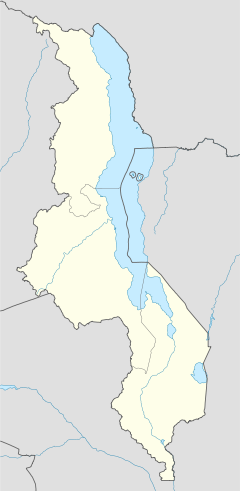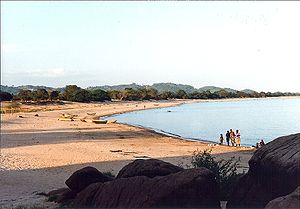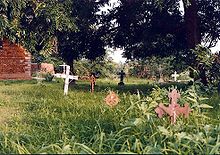- Nkhotakota
-
Nkhotakota Traditional mud and thatch houses on the beach of Lake Malawi in Nkhotakota Location in Malawi Coordinates: 12°55′00″S 34°18′00″E / 12.9166667°S 34.3°ECoordinates: 12°55′00″S 34°18′00″E / 12.9166667°S 34.3°E Country  Malawi
MalawiRegion Central Region District Nkhotakota District Elevation 1,548 ft (472 m) Population (2008)[1] - Total 33,150 - Languages Chichewa Time zone +2 Nkhotakota (formerly Kota Kota) (name derived from the Chichewa for "Corner Corner") is a town and one of the districts in the Central Region of Malawi. It is on the shore of Lake Malawi (formerly Lake Nyasa) and is one of the main ports on Lake Malawi. As of 2008, Nkhotakota had a population estimated at 33,150. The district had a population of 301.000.
Contents
History
Nkhotakota was originally a group of villages in the 19th century which later served as a market for Arabian slave traders.[2] David Livingstone convinced Chief Jumbe to stop trading slaves under a tree in Nkhotakota in the 19th century, which is currently in existence under a mission.[3] Later Malawi president Hastings Banda gave speeches under another tree in Nkhotakota during the 1960s, this one ironically known as the Livingstone Tree.[3] This town was hit by the 2001 floods, and was the worst hit area of Malawi's Central region.[4] Today, Nkhotakota is the largest traditional African town in Malawi[2] and bears a strong Swahili-Arab influence.[5]
Geography
Nkhotakota lies at an elevation of 1,548 feet (472 m) on the shore of Lake Malawi.[2] It is located on a rocky ridge overlooking a natural harbor overlooking Nkhotakota Bay, formed by a sandbar.[2] In addition, Nkhotakota is 200 kilometres (120 mi) from Lilongwe, Malawi's capital, and 378 kilometres (235 mi) from Blantyre, Malawi's largest city.[6]
Wildlife
Nkhotakota is home to the Nkhotakota Wildlife Reserve, where, according to Lonely Planet, one has a good chance of seeing elephants.[7] The reserve is also home to several antelope species, buffalo, and leopards.[8] Several large rivers cross this reserve, the largest in Malawi.[3]
Roughly 24 kilometres (15 mi) south of Nkhotakota is the Chia Lagoon, a large bay linked to Lake Malawi by a narrow channel, crossed by a bridge near Nkhotakota's one major road.[3]
Economy
Locals fish on the Chia Lagoon using triangular nets on poles.[3]
Demographics
Population development
Year Population[1] 1987 12,163 1998 19,421 2008 33,150 Languages
Chichewa is the main language spoken in this town.[9] A Swahili settlement was also established in Nkhotakota.[10] Several Chewa speakers live to the south of Nkhotakota,[11] and Tonga is spoken in its north.[12]
Facilities
Medical
There are two hospitals in Nkhotakota: Nkhotakota District Hospital and St. Anne's Mission Hospital. However,in the whole district there are 23 health facilities including 1 district hospital, 1 mission hospital, 1 government rural hospital, 1 mission rural hospital, 11 health centres, 10 private clinics and 2 dispensaries.[13][14] In its efforts in the fight against HIV/AIDS, the Society for Women Against AIDS in Malawi (SWAM) implemented a two year project in Nkhotakota.[15] Nkhotakota is also a regional hub for the [World Medical Fund] - a UK-based medical charity, whose rural outreach services provide the region's villages with basic medical care including anti-retrovirals, anti-malarial treatment and infectious disease management.
Banks
A branch of the Malawi Savings Bank Commercial Bank of Malawi is located on the corner of the road from Kasungu in Nkhotakota, and the main north south road offering foreign exchange facilities. At present there are no credit card facilities which will hopefully change soon.[3]
Petrol stations
There is a BP petrol station in Nkhotakota.[3]
Nkhotakota Pottery
Nkhotakota Pottery is located 2.5 kilometres (1.6 mi) from Nkhotakota.[3] They offer a number of pottery courses, starting at US$90.[3]
Transport
Nkhotakota is one of the main ports on Lake Malawi,[16] and it is served by the ferry MV Ilala that weekly crosses Lake Malawi. The nearest airport is at Kasungu, 48 miles (77 km) away. A bus runs from Salima for two hours daily.[17] In addition, minibuses run from here to Nkhata Bay along the main road which connects these towns.[18]
References
- ^ a b "Malawi: largest cities and towns and statistics of their population". World Gazetteer. http://www.world-gazetteer.com/wg.php?x=&men=gcis&lng=en&dat=32&srt=pnan&col=dq&geo=-150. Retrieved 2008-06-27.
- ^ a b c d "Nkhotakota". Encyclopaedia Britannica. 2008. http://www.britannica.com/eb/article-9055985. Retrieved 2008-06-27.
- ^ a b c d e f g h i Murphy, Alan; Armstrong, Kate; Firestone, Matthew D.; Fitzpatrick, Mary (2007). Lonely Planet Southern Africa: Join the Safari. Lonely Planet. p. 197. ISBN 1740597451.
- ^ "More Rains, Renewed Problems". AllAfrica. 2001-03-21. http://allafrica.com/stories/200103210071.html. Retrieved 2008-07-01.
- ^ Murphy, p. 159.
- ^ "Malawi distance table". Wild Malawi. 2008. http://www.wildmalawi.com/distance-table/distance-table/malawi-distance-table.html. Retrieved 2008-06-20.
- ^ Murphy, p. 31.
- ^ Murphy, p. 166.
- ^ Baldauf, Richard B.; Kaplan, Robert (2004). Language Planning and Policy in Africa: Botswana, Malawi, Mozambique and South Africa. p. 85. ISBN 1853597252.
- ^ Baldauf, p. 91.
- ^ Baldauf, p. 82.
- ^ Baldauf, p. 84.
- ^ http:www.nkhotakota.com/health.html~~~~
- ^ "Poverty Reduction is Malawi's Priority". AllAfrica. 2002-10-17. http://allafrica.com/stories/200210170244.html. Retrieved 2008-07-02.
- ^ "SWAM in the Fight Against HIV/Aids". AllAfrica. 2007-05-07. http://allafrica.com/stories/200705071519.html. Retrieved 2008-07-02.
- ^ "Malawi: Transportation". Encyclopaedia Britannica. http://www.britannica.com/eb/article-43952/Malawi. Retrieved 2008-06-27.
- ^ Murphy, p. 176.
- ^ Murphy, p. 191.
External links
Categories:- Populated places in Malawi
- Lake Malawi
- Central Region, Malawi
Wikimedia Foundation. 2010.




